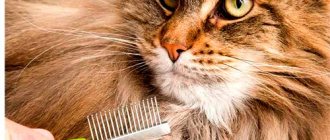What is estrus
Every individual experiences delight at the sight of small and cute animals. But life is designed in such a way that every living creature grows up, declaring such needs as procreation.
- A cat is not only a four-legged friend for the little inhabitants of the house.
- She also wants to be a mother and share love with her fur babies.
- Before a purr is ready to breed, a natural process called estrus or estrus occurs in her body.
- This indicates her puberty. After which she is able to bear and give birth to kittens.
Estrus is easily determined. This article will help even a beginner in cat breeding to understand the entire structure of the animal’s physiology.
Who's in danger
Regardless of the reason for the absence of symptoms in an infected person, all people around him, especially those at risk, are at risk. Let's look at it with an example.
Even if an infected person has no symptoms, all the people around him are still at risk.
A young man “caught” the virus at work and brought it home. His children may get sick in a mild/asymptomatic form, but elderly parents and relatives with chronic diseases, especially diabetes, obesity, heart and vascular diseases have every chance of getting a detailed picture of the disease with serious consequences.
Infection can occur even if the older generation lives alone. They just brought their grandchildren for the weekend. In appearance, the children are completely healthy, so grandparents do not suspect anything that during hugs and games, children release viral particles into the air with saliva.
Therefore, it is so important to remember that the incubation period lasts 2-3 weeks. With an asymptomatic course, the release of the virus from the body when talking, coughing, sneezing can also last up to several weeks.
It is important to follow the rules of wearing a mask and washing your hands, even for seemingly healthy people. So they care first of all not only about themselves, but also about others.
Signs of estrus
In order to determine ovulation in a cat, they take a closer look at its behavior. Main signs of estrus:
- The animal became affectionate. It will be especially noticeable if the pet has a wayward character;
- Arches the body so that the back part rises;
- Refuses to eat;
- Makes heart-rending sounds;
- She experiences increased urination and elimination;
- An animal living in the house may want to go outside.
Advice! Do not punish your cat for such indecent behavior. It is very difficult for her at this time. The owner should show maximum patience and love for his pet.
Sedatives for cats
Noticing that the animal is in heat, a caring owner is looking for a way to alleviate the pet’s condition. These days it is important to pay more attention to the cat, pet it, and pick it up. You can distract the female with active games. It is worth buying the animal a new toy and not allowing it to sleep all day, accumulating strength for the night concert. Given the decrease in appetite, it is necessary to reduce the size of portions and increase the frequency of feedings. The diet should be balanced.
The following homeopathic sedatives for cats can be found on sale:
- Cat Baiyun;
- Anti-Stress;
- Fitex;
- Stop stress.
Products made from plant extracts normalize the cat’s behavior before and during estrus. Such medications are not addictive. Reactions to sedative medications can vary, so you should consult your veterinarian when choosing a brand and dosage.
In extreme cases, hormonal drugs are used to interrupt estrus. You can resort to this measure no more often than once every six months. Abuse of medications containing hormones leads to disruption of the reproductive system and the appearance of tumors.
It is unacceptable to resort to the following methods of pacifying an animal:
- You cannot punish a cat for showing its emotions so clearly. During this period, the animal cannot control itself; its behavior is controlled by hormones.
- Bathing will stop the calling meow only temporarily. It should be remembered that water procedures are a lot of stress for a cat. Half an hour of peace is not worth the wasted nerves.
- Another stereotype is that if you keep a cat in a dark room, sexual heat will end faster. With a lack of lighting, the production of hormones decreases, but an animal left alone may experience mental disorders and attacks of aggression.
Types of estrus
Veterinarians distinguish four types of estrus in purring cats. By identifying these features, it will be easier for the owner psychologically to survive a difficult period in the animal’s life and decide on the mating date if there is a desire to breed animals.
During estrus, a cat goes through the following stages that determine its readiness to mate.
Preparatory phase or proestrus. Lasts from 1-4 days. Signs: The purr rolls along the surface of the floor and caresses the inhabitants of the house. Signs of the first discharge appear. It's too early to let the cat near the cat.
Estrus. The second stage lasts 5-10 days (it all depends on the breed of cat). It is characterized by a loud, incessant cry that the pet makes. This period cannot be skipped if the breeder decides to breed.
- Third stage or after estrus. It depends on whether fertilization has occurred.
- If a cat becomes pregnant, then after 60-70 days, she will give birth to offspring.
- There are cases when a false pregnancy occurs; there is no need to be afraid of this. This is how nature intended.
- Everything goes away in 30-45 days. If the animal did not participate in mating, then sexual desire is dulled within 2-15 days.
- After which the pet may experience aggressive behavior. You also need to wait out this period, everything will return to normal.
Anestrus or the fourth stage. Called the rest period. It lasts from three weeks to two months.
Symptoms and features of estrus
The onset of estrus is often accompanied by a change in the animal's behavior. During this period, the cat has practically no control over its behavior; it is under the complete power of instincts. This is why even the most well-mannered, but unsterilized, cats during the period of estrus often begin to go to the toilet in a place other than the litter tray. They mark their territory with their scent, thus attracting males.
We recommend the article: What causes bumps on the nose of cats?
The cat's egestive cycle is divided into several phases, which have their own symptoms:
- Precursor or proestrus. Hormonal changes begin to occur in the animal's body. A cat may become too affectionate and constantly ask for attention from its owner. At the same time, she is not yet ready for mating, and therefore does not allow cats to approach her and can react quite aggressively to them.
- Estrus or estrus. Swelling of the genital organs can be observed, and light, clear discharge is possible. The cat often licks itself under its tail. She behaves restlessly, rubbing herself against furniture, walls and her owner’s legs. The cat can press itself to the floor and raise its tail, inviting the male to mate. Often this period is accompanied by screams that do not stop day or night. The cat's appetite decreases. During this period, the animal may lose weight.
- Afterflow or metestrus. The cat no longer allows males to approach her. Often during this period she may already be pregnant. Sometimes after estrus in cats a state of false pregnancy occurs. If pregnancy does not occur, the hormonal levels gradually return to normal, and sexual desire subsides.
- Interestrus or Anestrus. This is a period of rest that occurs between heats. The animal is completely calm, all symptoms of estrus are completely absent. The cat shows no interest in cats.
In some cases, symptoms of estrus remain unexpressed. The owners may even be pleased with this course of events, because the behavior of the pet during a special period does not change at all. However, the absence of symptoms of estrus may indicate a malfunction of the animal's body. In addition, even cats with relatively calm heats are still at risk. They are susceptible to various diseases of the reproductive system.
If a cat is involved in breeding, but her estrus is mild, contact with a sexually mature cat can often change the situation. After this, the symptoms of estrus should become more pronounced. In some situations, the veterinarian may prescribe hormonal medications to the animal, which will help establish a normal estrus cycle.
When does the first estrus begin?
A cat's first heat usually begins at 6-9 months. It depends on the purr breed and living conditions. If you take a phlegmatic animal, then you can see a peculiarity in the period of the first estrus - 10-16 months.
Advice! If the first heat of a domestic cat is noticed earlier than four months or does not occur until a period of one and a half years. This is a reason to contact a veterinarian.
It is important to know that primary estrus is not a reason for an animal to mate. With normal physiological development, mating shifts 6 months later from the beginning of the primary estrus. During this time, the animal will become completely stronger and will be able to give birth to healthy offspring in the future.
Important! Experts advise skipping the initial 2-3 heats before mating.
How to calm a cat during heat
First of all, the owner should immediately decide whether his pet will participate in breeding. It should be noted that childbirth is a rather complex process. Some owners believe that childbirth will only benefit their pet. But this is far from true. Pregnancy consumes a lot of resources, it wears out the body. In addition, pregnancy is accompanied by various risks, which may well lead to the death of the mother and cubs. This is why you should not breed animals that have no breeding value. Pregnancy will not bring any benefit to the cat itself, and outbred kittens often end up on the street.
If the cat will not participate in breeding, it should be sterilized. Moreover, it is advisable to do this before the age of one. At this age, the animal’s body has not yet encountered hormonal storms. The uterus is small in size, it can be easily removed, and the animal will quickly recover after the operation. But it is worth noting that surgery done too early can lead to problems with urination in the animal. Therefore, it is advisable to sterilize a cat at the age of 6-7 months.
If the cat does not participate in breeding, or it cannot be sterilized for some reason, then there are other ways to help the pet. During this period, the cat really needs affection and attention. The pet should be petted more often and treated affectionately.
Even if the cat does not behave quite adequately, you should be patient. You shouldn't scold her. The cat cannot control some of its impulses, and it is not her fault. Taking your anger out on an animal, beating it, scolding it is not worth it. This can lead to mental disorders, due to which the cat may begin to behave inappropriately not only during periods of heat.
There are medications that can calm the animal. They are often made from various plant components. Such medications act as a sedative, but they do not stop the estrus itself. You should consult your doctor before giving your cat any medications. Some of them are not at all harmless - they can cause drowsiness and seriously affect the behavior and health of the animal.
There are also hormonal drugs. They are just capable of completely stopping estrus. But using them is strictly not recommended. Such medications lead to various diseases of the cat’s reproductive system. Hormonal drugs are good for the owner, since due to their effect the animal does not go into sexual heat. But these medications have a negative effect on the health of the animal, and therefore they should be purchased only as prescribed by a doctor.
Estrus frequency
How often does a cat go into heat? This is the question asked by every lover of four-legged friends who monitors its development and health. As a rule, the frequency of estrus depends on the characteristics of the breed. If you take the British Shorthair and the Siamese purr. The first is distinguished by infrequent estrus, unlike the second breed.
- Basically, under normal living conditions, a cat comes into heat once every three months.
- Another thing is a pet giving birth. The first estrus begins at 4-6 months after the kittens are born.
- But, you need to take into account this fact if the kittens died or were taken away. The cat will be ready for mating before the time indicated above.
How to understand that you are sick
To confirm the diagnosis, methods are used that detect either viral RNA in samples (in saliva) or immunoglobulins (circulating in the blood) that are produced in response to the virus. But tests are not 100% accurate, so they can be done several times. Also, additional imaging methods (CT, X-ray of the lungs) help make an accurate diagnosis.
You can suspect an asymptomatic course in family members where there is at least one infected person and everyone else has close contact with him. But only tests can confirm this for sure if there were no symptoms.
Heat
During estrus, the pet can cause a lot of trouble for the breeder. Therefore, it is important to know how long estrus lasts in cats. There is no clear answer to this question.
Here everything again depends on the characteristics of the breed. Experienced breeders note that the average estrus period lasts from 5 to 10 days.
- It is worth paying attention if estrus is short or too long.
- This may be the first signs of disease in an animal (thyroid gland, cyst, tumor).
- If you suspect a health problem, contact a veterinarian immediately.
Advice! In order for the animal to feel calm and not annoy the owner during mating. You should contact a specialist who can help solve this problem.
Anestria, acyclia and other disorders
Anestria is the absence of cycles in cats. However, this condition is different from seasonal non-estrus, which lasts from October to December. There are many reasons for this: improper feeding or care, hormonal imbalances, etc.
Veterinarians identify a number of factors that increase the risk of anestrus:
- lack of daylight (usually growing days contribute to a surge in sexual activity);
- absence of other cats in the house;
- hypothyroidism - insufficiency of thyroid function;
- underdevelopment of the ovaries or the absence of this organ (if the cat was taken from the street, it could have been sterilized by the previous owner).
Acyclia is primary anestheria. This is the name for a disorder in which the cat has not come into heat by the second year of life. Veterinary medicine explains this by true and false hermaphroditism, the absence of one X chromosome.
Crowded nursery conditions cause sexual dysfunction
Young individuals are characterized by false pregnancies that develop even without mating. The condition can be triggered by the owner’s caresses or simply the smell of the cat. The fact that a cat has a false pregnancy is indicated by a delay in estrus after 40–50 days. Laboratory tests in this case show elevated progesterone levels in the absence of other pregnancy symptoms.
Nuances of sterilization
The most frequently asked question on the Mustachioed Pets websites and in the veterinary service: “Is it possible to sterilize a cat during heat?”
In order not to harm your beloved pet during sterilization, the following nuances are taken into account:
- The operation takes place during the period of sexual rest. Two weeks before and after estrus;
- To avoid breast cancer, sterilization occurs before the first estrus;
- At the time of surgery, the cat should be 6-8 months old;
- An animal is sterilized if it weighs at least 3 kg.
The above recommendations will help not only the cat, but also its owner, to get through the difficult period associated with the animal’s physiological estrus.
A sterilized cat is in heat
It happens that even sterilized cats continue their estrus cycle. There may be several reasons for this:
- The operation was performed incorrectly.
- The ovaries were not removed, or ovarian tissue remained in the abdominal cavity.
- Sex hormones are secreted by a tumor, which can be located in the uterus, mammary glands, adrenal gland, or pituitary gland.
- The adrenal glands and pituitary gland continue to produce sex hormones even after the ovaries are removed.
We recommend the article: Rectal prolapse in cats: treatment, prevention measures
Often, the attenuation of sexual behavior does not occur immediately after sterilization. Sex hormones still circulate in the cat’s body, which lead to behavioral abnormalities. Sexual behavior subsides approximately 2-8 weeks after surgery. But in some animals it can last much longer. This is especially true for cats that have been spayed during estrus.
The age of the cat also affects how quickly the animal's behavior is corrected. The more heats a cat has experienced, the older she is, the greater the chance that sex hormones will begin to be actively secreted not only by the ovaries, but also by other glands. This means that late sterilization of a cat may not be effective in correcting the animal’s behavior. The cat will not be able to become pregnant after the operation, but signs of sexual heat will continue to be observed in the future.
Deviations from the norm
For most pets, estrus is calm and painless. However, some cats are susceptible to hormonal imbalances or have a predisposition to abnormalities.
Prolonged heat
This refers to estrus that has lasted for more than 14 days. The phases of the physiological process are extended, going beyond a certain norm. At this time, mucous discharge does not stop, but at the same time the cat is aggressive and does not allow the cat to approach, so fertilization does not occur.
Anaphrodisia
This is the complete absence of any signs of estrus in an adult cat. A delay in normal puberty is accompanied by a similar deviation. In any case, the animal must be shown to a competent veterinarian, who will prescribe treatment.
False pregnancy
If fertilization does not occur, but all the symptoms of pregnancy are present, a false pregnancy appears. The pathological condition is determined by the doctor.
Some breeds, such as Sphynxes, have a predisposition to such manifestations. In most cases, it is still a psychological problem that develops due to stress.
The animal's behavior also changes. The cat looks for a secluded place, often carries soft objects in its teeth, considering them its children, while its stomach and mammary glands swell, its appetite and thirst increase. The pathological condition is dangerous due to the development of a complication – purulent mastitis.
Empty heat
This is a situation when the estrus has ended, but the pet has not become pregnant. This condition is dangerous due to the development of ovarian cysts, inflammatory processes in the reproductive system and even cancerous tumors.
If the owner does not plan to go through the procedure of mating animals, it is better to immediately sterilize the pet.
Bloody issues
According to the norms, a cat should not have bloody inclusions in its discharge. If such a phenomenon was noticed by the owner, it is better to immediately show the animal to an experienced veterinarian to determine the problem.
Frequency of estrus
If there has been mating, fertilization and pregnancy occur, this stops the estrus. On average, the pet bears kittens for 2-2.5 months, and she does not give birth.
After childbirth, physiological processes are restored after about 3.5 months. The onset of estrus is observed earlier if the litter is stillborn.
If pregnancy does not occur, estrus continues as usual. The intervals between them range from 1 to 3 weeks.
It depends on individual characteristics:
- animal physiology;
- season;
- living conditions;
- breed.
British and Scottish Fold cats go into heat less frequently than Siamese and Persian cats. In the autumn-spring period, sexual activity increases significantly.
Need to run
During heat, instinct - again - causes the cat to rush to the door when it opens. There are potential suitors outside, and her need to attract them and connect with them becomes obvious. During this time, it is likely that the indoor cat will run away for more than a day and up to a week, or even longer. Be sure to close all escape routes and keep a close watch. You might even want to distract her with a game to take her mind off the task at hand.
© shutterstock











